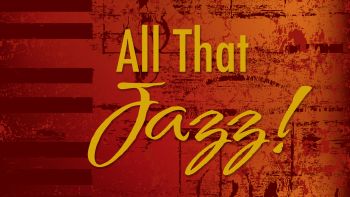All That Jazz! 03•06•22
Program
New York 1927, by Warren Barker
Warren Barker (1923–2006) was born in Oakland, California, and attended college at the University of California, Los Angeles. Best known as a composer for television, he scored, arranged, and conducted music for more than 30 prime-time shows—most notably, the 1960s series Bewitched. He won an Emmy Award in 1970 for the music for the short-lived sitcom My World and Welcome to It, based on the writings of humorist and cartoonist James Thurber. Barker also composed and arranged many pieces for concert band. “New York: 1927” captures the many moods of New York City in the 1920s. It begins with a lively ragtime section, segues into a blues section reminiscent of Gershwin, and ends with an animated section depicting the hustle and bustle of the city streets—complete with taxi horns and police whistles.
St. Louis Blues March, by W. C. Handy
W. C. Handy (1873–1958) is often referred to as the Father of the Blues. His ever popular “Saint Louis Blues” was first published in 1914 and was one of the first blues songs to succeed as a pop song. It remains a fundamental part of the jazz musician’s repertoire. Louis Armstrong, Bing Crosby, Bessie Smith, Count Basie, Glenn Miller, Guy Lombardo, and the Boston Pops Orchestra (under the directions of both Arthur Fiedler and Keith Lockhart) are among the artists who have recorded it. “Saint Louis Blues March” was arranged for band by Jerry Gray in 1948 and was first played during the big band era by groups led by Glenn Miller and Tex Beneke. Handy said his objective in writing the song was “to combine ragtime syncopation with a real melody in the spiritual tradition.”
Here’s that Rainy Day, by Johnny Burke (arr. B. Lowden)
James Van Heusen (1913–1990), whose given name was Edward Chester Babcock, was born and raised in Syracuse, New York. He began writing songs while in high school and at age 16 had a regular program on a local radio station. As a radio announcer, he adopted the last name Van Heusen, inspired by the men’s shirt manufacturer. Van Heusen studied music at Cazenovia College and Syracuse University and then moved to New York City, where he worked as a staff pianist for a music publisher. In 1938, after writing his own hit, he was put under contract. He began working with lyricist Johnny Burke (1908–1964), a native of Antioch, California, in 1939, and the two wrote “Here’s That Rainy Day” in 1953. Regarded as a twentieth-century jazz standard, the song has been performed by many jazz and pop singers, including Frank Sinatra, Tony Bennett, Rosemary Clooney, Lena Horne, and Peggy Lee. Both Van Heusen and Burke enjoyed tremendous success during their careers. Their song “Swinging on a Star,” from the Bing Crosby film Going My Way, won the 1944 Academy Award for Best Song in a Motion Picture.
It Might As Well Be Spring, by Richard Rodgers (arr. Stan Bann)
“It Might as Well Be Spring” was written by Richard Rodgers and Oscar Hammerstein for their film musical, State Fair (1945), which opened on August 30, 1945. The song was deemed average by critics yet went on to win the Academy Award for Best Original Song. Competition was stiff in those days, with a total of fourteen nominees. “It Might As Well be Spring” provided Rodgers and Hammerstein with their lone joint Oscar. An American standard that has been covered and recorded by countless legendary artists of varying genres, Stan Bann arranged “It Might as Well Be Spring” as a trombone feature for concert band.
Stan Bann, trombone soloist
Sunflower Slow Drag, by Scott Joplin (arr. John Bourgeois)
Before there was jazz, there was ragtime, and the undisputed king of that slightly more relaxed genre was Scott Joplin (1868–1917), who became famous after the 1899 publication of his “Maple Leaf Rag.” His upbringing in a musical family led Joplin to try his hand at composing waltzes and marches, but it was his rags that would win him acclaim. “Sunflower Slow Drag” was composed in collaboration with a protégé, Scott Hayden. This “song without words” is, despite its title, one of Joplin’s most energetic scores. The original music was composed for solo piano. Col. John R. Bourgeois, USMC (Ret.), arranged “Sunflower Slow Drag” for band in 2012.
Someday Sweetheart, by John and Reb Spikes (arr. Stan Bann)
“Someday Sweetheart” is a jazz standard written by Los Angeles-based musicians John and Reb Spikes in 1919. It was the biggest hit the brothers wrote and was performed by many recording artists of the period. Jazz luminary Pete Fountain credits the time he spent on the Lawrence Welk television show as the turning point in his career. While only on the show for two years his clarinet playing and charm won the hearts of fans everywhere. “Someday Sweetheart” is an adaptation of his 1958 rendition, newly arranged for concert band by Stan Bann.
Cheryl Bann, clarinet soloist
Alexander’s Ragtime Band, by Irving Berlin (arr. Jeff Taylor)
“Alexander’s Ragtime Band” is a Tin Pan Alley (epicenter of American music composition, lyric writing, and sheet music publishing from 1880 to the Great Depression) song by Russian American composer Irving Berlin, released in 1911. Although not a traditional ragtime song, Berlin’s jaunty melody nonetheless sold a million copies of sheet music in 1911, then another million in 1912, and continued to sell for years afterward. “Alexander’s Ragtime Band” sparked an international dance craze in places as far away as Berlin’s native Russia. Arranger Jeff Taylor has taken the ever-popular Irving Berlin standard and given it a creative treatment, including a swing-march, Dixieland style, 6/8 march, and driving big-band swing.
— Intermission —
An American in Paris. by George Gershwin (arr. J. Krance)
“An American in Paris” is a jazz-influenced orchestral piece by American composer George Gershwin (1898–1937), first performed in 1928. It was inspired by time Gershwin spent in Paris and evokes the sights and energy of the French capital during the Années folles (referred to as the Roaring Twenties or Jazz Age in the United States). Gershwin returned from France with the horn of a French taxicab and the sketch of a melody. This piece is considered a “tone poem,” which is a musical work designed to portray a particular story, scene, idea, or mood. Gershwin said, “The rhapsody is programmatic in a general impressionistic sort of way, so that the individual listener can read into the music such episodes as his or her imagination pictures. The opening section is followed by a rich ‘blues’ with a strong rhythmic undercurrent. The blues rises to a climax followed by a coda in which the spirit of the music returns to the vivacity and bubbling exuberance of the opening part with its impressions of Paris.”
Come Sunday, by Duke Ellington (arr. P. Murtha)
Duke Ellington (1899–1974) once said, “By and large, jazz has always been like the kind of a man you wouldn’t want your daughter to associate with.” Yet, this master of jazz has a hymn in the United Methodist Hymnal. Duke Ellington composed “Come Sunday” in 1943 as part of his extended composition, “Black, Brown, and Beige.” In this tone poem, “Come Sunday” represents the spiritual side of the people as they attend Sunday morning church services. In 1958, Ellington added text to this instrumental theme and the song became a standard of his sacred jazz concerts. With lush scoring and beautiful harmonies, here is a marvelous adaptation of this moving ballad featuring solo alto saxophone.
Tim Kraft, alto saxophone soloist
Big Band Bash, by Bob Lowden
Robert “Bob” Lowden (1920–1998) was born in Camden, New Jersey, and as a child was engaged in music at home, at church, and in the public schools. After graduating from high school, he taught himself to write and orchestrate music by studying the works of big band leaders Benny Goodman, Tommy Dorsey, and Glenn Miller. Lowden left college to serve in World War II, and he spent the war at Fort Dix as a trombonist and arranger for the 322nd Army Band. After the war, he studied music at Temple University and worked as a band coach and general music teacher in the public schools. In 1958, Lowden became the primary arranger–composer for the 101 Strings, a popular orchestra that recorded hundreds of easy-listening albums, and he later arranged music for the Philadelphia Pops and the Ocean City Pops orchestras. The selections in “Big Band Bash” include “Artistry in Rhythm,” “Tuxedo Junction,” “Moonlight Serenade,” “Take the ‘A’ Train,” and “One O’Clock Jump.”
Pavanne, from Latin American Sinfoniette, by Morton Gould
Morton Gould (1913–1996), heralded as a child prodigy, was well known as both a pianist and a composer. During the Great Depression, he played piano in New York City movie theaters and was the staff pianist when Radio City Music Hall first opened. He also composed music for radio shows, entertaining an audience of millions with The Chrysler Hour radio show. Gould went on to compose works for Broadway plays, ballet companies, and symphony orchestras. “Pavanne,” written in 1938, is the second movement of Gould’s jazzy Latin American Simfoniette No. 2. Gould intentionally misspelled “Pavanne,” adding an extra “n” to make sure Americans would not pronounce it to rhyme with “vein.”
Sponsored by June and Fred Freese, “Gift of Music” donors
Highlights from Ragtime, by Stephen Flaherty (arr. Robert W. Smith)
Stephen Flaherty is an American composer of musical theatre. He works most often in collaboration with the lyricist/book writer Lynn Ahrens. They are best known for writing the Broadway musical “Ragtime,” which had its world premiere in Toronto on December 8, 1996. After fabulous reviews in the preview cities of Toronto and Los Angeles, “Ragtime” moved to Broadway. It was nominated for thirteen Tony Awards, two Grammy Awards, and won the Tony for Best Original Score, among several others. The title “Ragtime” comes from the musical style, “ragtime,” which is a uniquely American, syncopated musical phenomenon that swept the country in the late nineteenth and early twentieth centuries. This arrangement includes the songs “Ragtime,” Buffalo Nickel Photoplay, Inc.,” “Sarah Brown Eyes,” and “Wheels of a Dream.” Arranger Robert W. Smith is an American composer, conductor, arranger, and educator. In addition to arranging this “Ragtime” medley, Smith’s credits include many compositions and productions in all areas of the music field.
Sponsored by Jennifer and Andrew Peck, in memory of their father, Thomas M. Peck
Program notes by Sue Hinton
Upcoming Performances
Join our mailing list
Subscribe to our email newsletter to learn about upcoming concerts.


